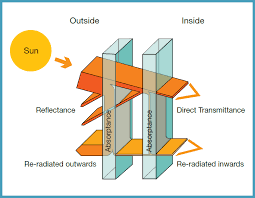What is Solar Control Glass?
Solar control glass is a product developed to allow sunlight to pass through a window or façade while radiating and reflecting away a large degree of the sun’s heat. The indoor space stays brighter and cooler in comparison to non-solar control glass types.
Solar control glass has a microscopically thin coating on one side that reflects heat from the sun back outside. This helps to prevent overheating in large areas of glazing. It can also reduce uncomfortable glare from direct sunlight.

How Does Solar Control Work?
Glass manages solar heat radiation by three mechanisms: Reflectance, Transmittance and Absorptance.
These are defined as follows:
- Reflectance – the proportion of solar radiation reflected back into the atmosphere.
- Direct transmittance – the proportion of solar radiation transmitted directly through the glass.
- Absorptance – the proportion of solar radiation absorbed by the glass.
Solar control glass has a microscopically thin coating on one side that reflects heat from the sun back outside. This helps to prevent overheating in large areas of glazing. It can also reduce uncomfortable glare from direct sunlight.
Benefits:
Using solar control glass allows for large areas of glazing without excessive heat build up in summer. This is particularly useful in glass conservatory roofs or south facing glazed areas. Our solar control products can be used to balance solar control with high levels of natural light.
- Reflects heat from the sun to keep interiors cooler, even with large areas of glazing such as façades and offices.
- Less need for costly air conditioning or unsightly blinds for maximum light and a feeling of space.
- An energy efficient way to keep interiors cooler.
- Filters uncomfortable glare from the sun, whilst letting in lots of natural light.
Solar control glass can be combined with many other products for multi-functional glazing including low-maintenance, noise reduction, decorative glass, enhanced safety, security and anti-fade glass.
Please click the downloads below for more information on just some of the solar control products we manufacture and offer to our customers.
Anti-Fade Glass
If you have sunlight which floods into your home causing problems with carpets, soft furnishings etc, please consider our Anti-fade laminate available in 6.4mm it can be used as single glazed in old traditional windows, secondary glazing or manufactured into sealed units.
Our Anti-fade Laminate offers all the traditional benefits of laminated glass, such as improved safety, enhanced security, durability and acoustic properties. Furthermore, it provides protection from UV radiation (UVA and UVB) by blocking over 99% of UV transmittance, helping to reduce fading of the contents and interiors of commercial properties and homes.
Energy Factors
Light Transmittance is the amount of light coming through the glass. 100% would be no glass at all therefore a good light transmittance would be upwards of 70%.
Reflectance is the amount of light reflected away from the building, so for example a 39% reflectance value would appear highly reflective / mirrored when looking at the outside of the glass.
Indoor reflectance values are how much of your own reflection you can see when you are looking out of the glass.
Solar Factors
G Value is the most common terminology for total solar transmittance or solar gain, a low g value of say 35% would meant that 55% of the solar heat would be kept in the building by the glass.
There is generally a link between Low G Value and Light Transmittance in that to obtain a low g value – good solar properties – a tint generally has to be applied to the glass thus reducing the light transmittance.
Shading co-efficient is a measure of the total amount of heat passing through the glazing.
